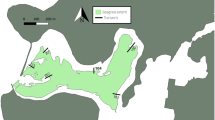Abstract
Both winter photosynthesis and the release of extracellular DOC are commonly ignored in stream production studies. We examined these contributions in a second-order stream under a completely closed deciduous canopy. We estimate that in Sandy Run approximately 26% of the annual autochthonous particulate carbon is produced between December and March. Measured winter rates of photosynthesis were not significantly different than summertime rates. Contrary to implicit assumptions often made about stream primary productivity, winter production was as important as summer production. Highest rates of carbon assimilation, however, were measured in the spring and fall, and were significantly correlated with standing crops of stream algae as measured by chlorophyll concentration. The recovery of released DOC from stream algae indicated that this contribution was equivalent to 5% of the particulate contribution. Rates of DOC production were significantly correlated with rates of particulate production. We estimate that had winter photosynthesis and extracellular DOC production been ignored in Sandy Run, annual productivity would have been underestimated by about a third.
Similar content being viewed by others
References
Aloi, J. E., 1990. A critical review of recent freshwater periphyton field methods. Can. J. Fish. aquat. Sci. 47: 656–670.
Anderson, N. H. & K. W. Cummins, 1979. Influences of diet on the life histories of aquatic insects. J. Fish. Res. Bd Can. 36: 335–342.
Baines, S. B. & M. L. Pace, 1991. The production of dissolved organic matter by phytoplankton and its importance to bacteria: patterns across marine and freshwater systems. Limnol. Oceanogr. 36: 1078–1090.
Busch, D. E. & S. G. Fisher, 1981. Metabolism of a desert stream. Freshwat. Biol. 11: 301–307.
Cole, J. J., G. E. Likens & D. L. Strayer, 1982. Photosynthetically produced dissolved organic carbon: An important carbon source for planktonic bacteria. Limnol. Oceanogr. 27: 1080–1090.
Cummins, K. W., J. R. Sedell, F. J. Swanson, G. W. Minshall, S. G. Fisher, C. E. Cushing, R. C. Peterson & R. L. Vannote, 1983. Organic matter budgets for stream ecosystems: problems in their evaluation. In: Barnes, J. R. & G. W. Minshall (eds), Stream Ecology: Application and Testing of General Ecological Theory. Plenum Press, NY: 299–353.
Dawson, F. H., 1980. The origin, composition and downstream transport of plant material in a small chalk stream. Freshwat. Biol. 10: 419–435.
Fisher, S. G., 1977. Organic matter processing by a stream segment ecosystem: Fort River, Massachusetts, USA. Int. Rev. ges. Hydrobiol. 62: 701–727.
Fisher, S. G. & G. E. Likens, 1973. Energy flow in Bear Brook, New Hampshire: an integrative approach to stream ecosystem Metabolism. Ecol. Monogr. 43: 421–439.
Hill, B. H. & J. R. Webster, 1982. Periphyton production in an Appalachian river. Hydrobiology 97: 275–280.
Hornick, L. E., J. R. Webster & E. F. Benfield, 1981. Periphyton production in an Appalachian Mountain trout stream. Am. Midl. Nat. 106: 22–36.
Hynes, H. B. N., 1963. Imported organic matter and secondary productivity in streams. Proc. Int. Cong. Zool. 16: 324–329.
Jasper, S. & M. L. Bothwell, 1986. Photosynthetic characteristics of lotic periphyton. Can. J. Fish. aquat. Sci. 43: 1960–1969.
Kaplan, L. A. & T. L. Bott, 1982. Diel fluctuations of DOC generated by algae in a piedmont stream. Limnol. Oceanogr. 27: 1091–1100.
Kaplan, L. A. & T. L. Bott, 1985. Acclimation of stream-bed heterotrophic microflora: metabolic responses to dissolved organic matter. Freshwat. Biol. 15: 479–492.
Keithan, E. D. & R. L. Lowe, 1985. Primary productivity and spatial structure of phytolithic growth in streams in the Great Smoky Mountains National Park, Tennessee. Hydrobiology. 123: 59–67.
Lock, M. A.& H. B. N. Hynes, 1976. The fate of ‘dissolved’ organic carbon derived from autumn-shed maple leaves (Acer saccharum) in a temperate hard-water stream. Limnol. Oceanogr. 21: 436–443.
Mayer, M. S. & G. E. Likens, 1987. The importance of algae in a shaded headwater stream as food for an abundant caddisfly (Trichoptera).J. N. Am. Benthol. Soc. 6: 262–269.
Minshall, G. W., 1978. Autotrophy in stream ecosystems. Bio-Science 28: 767–771.
Naiman, R. J.& J. R. Sedell, 1980. Relationships between metabolic parameters and stream order in Oregon. Can. J. Fish. aquat. Sci. 37: 834–847.
Richardson, J. S., 1992. Coarse particulate detritus dynamics in small, montane streams of southwestern British Columbia. Can. J. Fish. aquat. Sci. 49: 337–346
Rosenfeld, J. & J. C. Roff, 1991. Primary production and potential availability of autochthonous carbon in southern Ontario streams. Hydrobiology 224: 99–109.
Saunders, G. W., F. B. Trama & R. W. Bachman, 1962. Evaluation of a modified C14 technique for shipboard estimation of photosynthesis in large lakes. Great Lakes Research Division Publication No. 8. Ann Arbor, Michigan.
Schindler, D. W., R. V. Schmidt & R. A. Reid, 1972. Acidification and bubbling as an alternative to filtration in determining phytoplankton production by the 14C method. J. Fish. Res. Bd Can. 29: 1627–1631.
Strickland, J. D. H. & T. R. Parsons, 1968. A practical handbook of seawater analysis. Fisheries Research Board of Canada Bulletin 167. Ottawa.
U.S.D.A. 1979. Soil Survey of Crawford County, Pennsylvania. Soil Conservation Service, U.S.D.A.
Vollenweider, R. A., 1974. A manual on methods for measuring primary production in aquatic environments. International Biological Program Handbook No. 12. Blackwell Scientific Publishers, Oxford.
Webster, J. R., 1983. The role of benthic macroinvertebrates in detritus dynamics of streams: a computer simulation. Ecol. Monogr. 53: 383–404.
Webster, J. R. & J. L. Meyer (eds.), 1997. Stream organic matter budgets. J. N. Am. Benthol. Soc. 16: 3–161.
Webster, J. R., S. W. Golladay, E. F. Benfield, D. J. D' Angelo & G. T. Peters, 1990. Effects of forest disturbance on particulate organic matter budgets of small streams. J. N. Am. Benthol. Soc. 9: 120–140.
Author information
Authors and Affiliations
Rights and permissions
About this article
Cite this article
Ostrofsky, M.L., Weigel, D.E., Hasselback, C.K. et al. The significance of extracellular production and winter photosynthesis to estimates of primary production in a woodland stream community. Hydrobiologia 382, 87–96 (1998). https://doi.org/10.1023/A:1003441206055
Issue Date:
DOI: https://doi.org/10.1023/A:1003441206055




